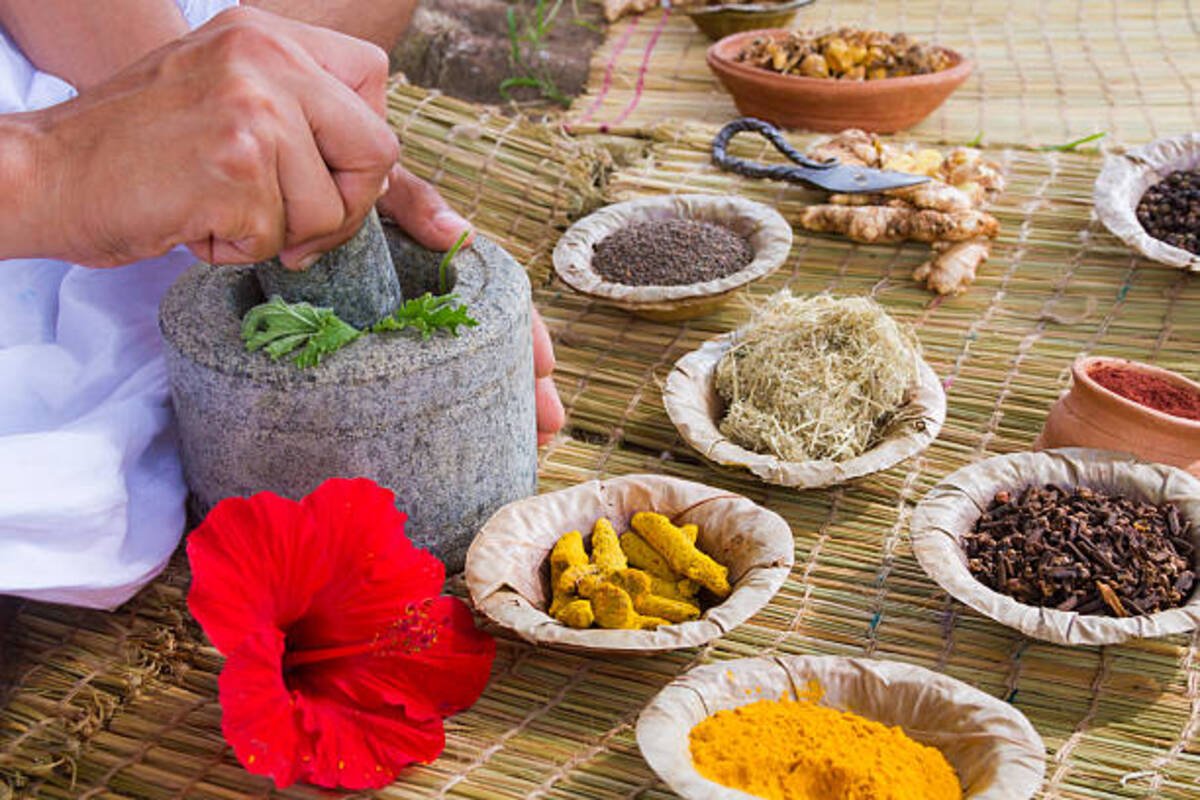Access your agni and fix your food coma gas, and bloating with simple tips and helpful herbs for digestive health.
Table of Contents
ToggleThe three stages of digestion
According to Ayurveda, gas, bloating, belching, burning, unhealthy weight gain, food intolerances and issues with elimination – which affect 74% of the population may be due to an incompletion of the three Ayurvedic digestion stages, while stressed, or on the run; or eating too slowly, a variety of indigestion symptoms related to ama (undigested food) can ensue. Step one is restoring digestive health is to support each of the three stages of the digestion.
STAGE 1: Pitta increases in the stomach
The first stage of digestion, the Pitta phase, starts about half an hour before each meal, with the onset of hunger pangs, a growing stomach, or the enticing aroma of a kitchen during meal preparation. Then stage 1 continues for about half an hour after the meal has been completed.
If you compare the three stages of digestion to cooking rice, stage 1 is the addition of heat or digestive fire (agni). Then you can break down stage 1 even further, into two parts:
- The half hour before eating is when you boil water before adding rice.
- The half hour after eating is akin to adding the rice to the boiling water. Just like the water starts to change the chemistry of the rice, gastric juices, hydrochloric acid, pepsin, and mucus in your stomach start to break down food. In Ayurveda, this is called Pachaka Pitta, which includes the two types of digestive agnis, called Jathara Agni and Pachagni.
STAGE 1: Tips to increase digestive fire
- Make sure you are relaxed when sitting down to eat. This increases your rest-and-digest parasympathetic nervous system response and neurologically turns on your digestive system.
- Sip ginger tea before and with meals.
- Drink ¼ of a squeezed lemon with 1 tsp. honey and a pinch of salt in one cup of hot water before eating, or with food.
- Take ginger, coriander, cumin, fennel and cardamom with meals. These five spices make up the life of your meals for a gentle digestion.
- After meal, rest on your left side for 10-15 minutes. This allows gravity to help your stomach fully prepare for food stage 2 in the small intestine.
BONUS TIP: Drinking large glass of water a half hour before your meal may help with healthy weight loss. One study shows that pre-hydrating your stomach lining with water will boost production of a productive bicarbonate layer, which is 94% water. Increasing bicarbonate production allows the stomach to secrete greater amounts of acid to initiate the break down of proteins. Ensure to drink at least a half hour before your meal. According to Ayurveda, drinking the same amount of water right before or during the meal would actually drown out the stomach’s digestive fire and cause further indigestion.
STAGE 2: Kapha increases in the small intestine
In the second stage of digestion, which starts about a half an hour after eating, food leaves your stomach and enters the small intestine. When we compare this to cooking rice, this would be when we turn the fire down and let the rice simmer for about 20 minutes. In the digestive track, this can take one to three hours, depending on the size of the meal and the constitution of the person.
This phase of digestion, known as the Kapha phase, is rushed, or if you overeat, particularly highly manufactured, non-organic products (without natural digestive boosting microbes), food will sit heavily in your small intestine, taking longer to process. This can cause a “food coma”, or feelings or tiredness, gassiness, and bloating, plus create problems with assimilating nutrients form the food, and finally, with elimination.
During Stage 2 of digestion, Pachaka Pitta in the stomach and duodenum, or the first part of the small intestine, join forces with the bile flow from your liver and gallbladder, called Ranjaka Pitta. Ranjaka Pitta emulsifies fats, scrubs the intestinal wall, governs stomach emptying, buffers acids, and regulates bowel function.
During Stage 2, pancreatic enzymes, digestive acids, mucus, and buffers that neutralize the stomach acid all combine to form the food bolus or, in Ayurveda, Ahara Rasa (Ahara = food, Rasa = lymph). Ahara Rasa is the process in which food becomes the body’s lymph-based nutrient fluid and is absorbed through the intestinal wall. This fluid is the primary building block of the seven major tissues (dhatus): lymph, blood, muscle, fat, bone, and nerve and reproductive tissues. If Ahara Rasa isn’t completely formed, digestion and assimilation will be sluggish and heavy and your blood and lymph can become toxic.
This process simply takes time. It usually takes about one to three hours for your body to completely break down food and start assimilating and disturbing its nutrients. When this process is disturbed, ama accumulates and aggravates the delicate intestinal environment and alters the balance of beneficial microbes or Krimi (the invisible bacteria described thousands of years ago) in your digestive system. Imbalances in the stage of digestion will cause irritation in the large intestine, which is responsible for gut immunity, nutrient and mineral assimilation, and housing the body’s microbiome, or second brain.
STAGE 2: Tips for breaking down and assimilating nutrients
- After resting on your left side, take a walk to help complete the Kapha stage of digestion. Wait until the Kapha stage is complete before exercising.
- Bitter foods balance Kapha in Stage 2. Consume more leafy greens, brussels, sprouts, green cabbage, olives, bitter gourd and fenugreek.
- Supplement with bitter roots such as dandelion, turmeric, burdock, barberry, Oregon, grape, guduchi, amalaka or goldenseal. (Or supplement with combination of turmeric, phyllanthus, barberry and guduchi).
- Drink apple-beet-celery juice 6-8 ounces a day to support healthy bile flow from liver and gallbladder.
- More agni in your stomach also stimulates increased bile and digestive enzyme production, so the tips above for Stage 1 can help in Stage 2 as well.
- Excess Kapha in Stages 1 and 2, particularly in your stomach and small intestine, can cause food to linger, creating excess mucus production, bloating, belching, gas and fatigue. Trikatu or a combination of ginger, pippili or long pepper and black pepper – is the classic Ayurvedic Digestion remedy for excess Kapha in Stages 1 and 2.
STAGE 3: Vata returns
In the Stage 3, the Ahara Rasa, or food bolus, moves from your small intestine to your large intestine. In our rice metaphor, this stage is the stage in which the rice has been properly cooked and is ready to eat. The heat is turned off, the lid is removed and air, or Vata, bathes the rice – and the now empty small intestine.
Once food enters your large intestine (the seat of Vata), the upper digestive process is complete and an urge to have a bowel movement may occur. If you are hungry, you can now safely eat another meal. If you eat another meal during the Pitta and Kapha stages of digestion, before Vata comes back into the stomach and small intestine, food won’t properly or completely break down, creating ama that congests the liver, lymph, and intestines, or is stored as unwanted fat, along with causing a variety of indigestion symptoms.
Imagine trying to feed more people by adding more rice into a pot of rice that is already simmering? This is what is happening in your digestive system when you eat again too soon.
STAGE 3: Tips for elimination
- Eat more soluble fiber (grains, seeds, cooked foods) in the winter.
- Eat more insoluble fiber (fruits and vegetables) in the spring and summer.
- If you have firm, dry stools, consider taking Triphala Churna tea, slippery elm or licorice.
- If you have loose stools, consider, bilva fruit to absorb toxins and reactive mucus and soothe irritated intestinal lining or herbal medicines containing shunthi (dried ginger), dadima (pomegranate), Triphala, cardamom, nutmeg, nutgrass in its formulation.Ayurvedic Digestio
MONITOR THREE STAGES OF Ayurvedic DIGESTION IN YOUR OWN PULSE
In Ayurveda, men measure pulse on their right wrist, while women measure it on their left wrist. Men: reach with your left hand under your wrist and take your pulse with your index finger closest to the fingers of the right hand. Women: do the opposite. It helps to keep your elbows in, so that your pulse can line up over the radial artery, which runs in a straight line up the thumb side of the arm.
Your fingers should be touching each other, but not squished together. Press into the radial artery to feel your pulse with the tips or pads of your fingers.
Push down with all three fingers until you can feel a pulse under each one. The first thing you may notice is that each pulse is different. Each pulse corresponds to a different dosha, or element, in your body.
- Your index finger reads vata pulse.
- Your middle finger reads pitta pulse.
- Your ring finger reads kapha pulse.
During Stage 1 of digestion, when you are preparing to eat or are eating, you should feel your middle (pitta) pulse becoming stronger.
During Stage 2 of digestion, when you are taking it easy after a meal by resting or walking, you should feel your ring finger (kapha) pulse becoming stronger.
During Stage 3 of digestion, when vata enters the small intestine and the digestion of the prior meal is complete, you should feel your index finger (vata) pulse becoming stronger. If you do not feel these stages, you may have an underlying digestive imbalance.









